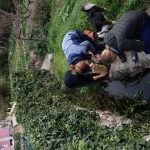Underground mirror
Springs and wells represent a window into the underground world, and their biodiversity tells us about the purity of underground water. In January, we spent a week in warm Dubrovnik, visited springs and wells in the wider city area, and collected fauna samples. To present the wonderful world of caves and pits, we held a lecture in the Dubrovnik libraries and a workshop for the Ivan Gundulić Elementary School students in Dubrovnik.
The field research took place as part of the activities of the project “Underground mirror – underground waters of the tourist pearl of the Adriatic”, which was co-financed within the framework of the Public call for co-financing projects of associations in the field of environmental and nature protection of interest to the City of Dubrovnik for 2022.
- Slavljen (Vrelo) spring – the spring of the medieval water supply system of Dubrovnik (photo: D. Kermek)
- Žljebovoda – spring is used since the Illyrian time (photo: L. Okićki)
- Measurement of physical and chemical parameters, Palata spring (photo: N. Kuharić)
- When you don’t carry boots, you take a bath (photo: L. Okićki)
- “Puč” Staro Brezumilo – After the rains, in the past, people dug in search of water in places where the ground was wet for a longer time. If they found underground water, they would wall off and cover the so-called “puč”. (photo: L. Okićki)
- Who lives in Tundrača spring? (photo: L. Okićki)
- Bistra (Clear) spring in Zaton Mali. Due to the higher water temperature than all the surrounding springs, it was nicknamed “Warm spring” during the first visit. (photo: N. Kuharić)
- Lecture for schoolchildren (photo: L. Okićki)
- Thank you City of Dubrovnik!














